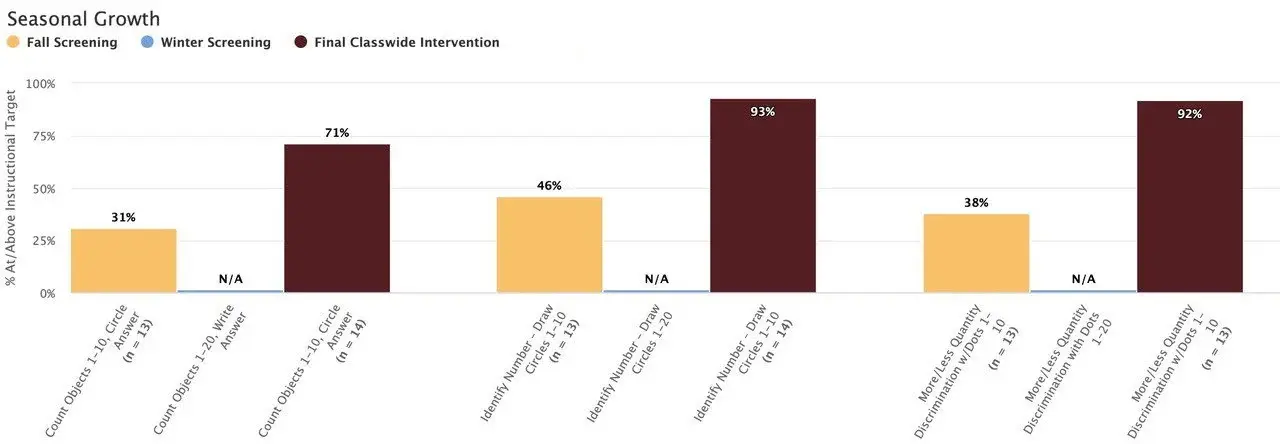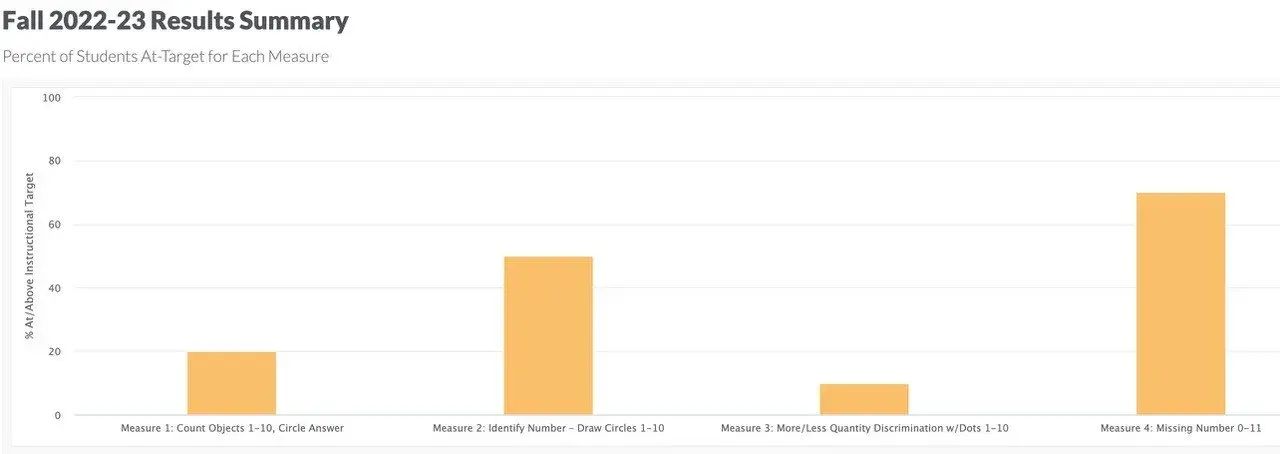Math intervention implementation - consistency adds up
Doing the work, staying the course, and other lessons learned
By guest writer:
Erica Fanning, Ph.D., School Psychologist , Coxsackie-Athens Central School District, New York
Math intervention is an ongoing struggle in education. Although my dissertation focused on fact fluency, I was struggling to use my expertise in practice and after fact fluency, I had nothing in my toolbox for math. This was problematic because for years our district has been hovering around 50-60% proficiency for our K-8 students according to the aMath FASTbridge benchmark assessments. Proficiency rates for state test scores and the algebra regents are lower than that. We would jump ahead attempting to quickly close gaps. Our hardworking and well-intentioned teachers wanted to do it all instead of focusing on one or two evidence-based interventions. Skill gaps felt overwhelming, and we rarely saw meaningful progress. Once students were put into intervention groups, they stayed there.
In the spring of 2022, three teachers with a passion for math joined me to explore SpringMath when they began classwide and small-group interventions. They regularly reported back to the MTSS team (which included school psychologists, interventionists, teachers, and administrators). We decided to expand our use of SpringMath in the 2022-23 school year. Given the churn of new Initiatives, COVID-19, and the growing social-emotional needs of students, we knew that a carefully crafted plan was only the beginning. In the section below, I will share some of the lessons we learned in the early stages of our implementation.
Leader support is paramount
The assistant superintendent shifted personnel, and two teachers who implemented spring of 2022 became half-time math coaches/half-time interventionists for 2022-23, which was crucial. Scheduling was also important. When SpringMath was built into the schedule, interventions occurred 4-5 times per week. Without preset schedules, specials, and pull-out services made it difficult for many teachers to include SpringMath 2-3 times per week. Regular feedback, conversations, and support from principals also seemed to improve intervention consistency and growth and improved faculty acceptance of the program.

Your coaches learn how to implement with your teachers
Our coaches are well-liked and respected teachers. They pushed in their support for classwide intervention and pulled students out for individual interventions, so they were in it with their colleagues. We worked closely with the SpringMath implementation specialist assigned to the district. The coaches taught their colleagues how to navigate the system, prepared materials, and assisted with data collection. All of this gave them credibility and addressed many of the antecedent strategies for implementation! Last year, 23 classroom teachers (70%) in grades K-6 began using SpringMath, while this year we have 30 classroom teachers (91%) on board. Only one teacher has opted out.
Create a central place for all the questions and answers for your teams
While the coaches met with teachers as needed, we also held monthly meetings to ask and answer questions and hear concerns. When necessary, we reached out to SpringMath, and we always received quick and thorough responses. We created a spreadsheet where teachers added questions or comments and we put answers in writing. This became sort of an internal document that we could refer to over time. Teachers tend to ask similar questions and you can also refer to the FAQs provided by SpringMath. In the spring of 2023, we scheduled a full day training with a SpringMath expert where the training focused on our data and the trainer worked with our teachers and leaders to troubleshoot implementation.

The link between concerns and fidelity
In our schools during our first year of implementation, our teachers worried that:
-
Expectations for student mastery in SpringMath were too high.
-
Perhaps related to the first worry, that they were spending too many weeks to get children to mastery on the skills.
-
Some SpringMath skills were presented too early or in a format that was not familiar to students.
-
Timed tasks caused anxiety.
|
Some of these concerns persist. We also had implementation integrity issues. Some teachers felt that students lacked social skills for partner work and removed this aspect and modeled skills themselves. Others allowed an extra minute for the completion of assessments or skipped error correction altogether. Some teachers excluded scores for students receiving individual intervention or special education services, even when the students participated in classwide intervention. I believe integrity issues often occur because of concerns and barriers. Teachers did not do error corrections because they ran out of time for skills requiring 80 problems. They adjusted times and removed scores because they felt expectations were unrealistic and believed students would never catch up if they didn’t move faster. The concern was logical, even though moving children on to new skills before they mastered prerequisite skills would actually worsen student progress in the long term. Teachers used their training and experience to problem-solve without realizing that changes can attenuate a program’s efficacy. No educator would purposely sabotage students’ chances for success, ut altering or removing the active ingredients of an effective tool means the tool may no longer be effective. |
In order to address these concerns and integrity issues, we directed teachers to the many resources available within SpringMath and explained that the skill sequences, cutscores, and problem formats were designed to ensure future success in algebra and a vigorous program of research showed exactly that effect when SpringMath is correctly used. We shared the Science of Math article and the Chalk and Talk Podcast to dispel the myth about timed tasks and math anxiety. Through that work, we built an understanding that the spring screenings were meant to be difficult, as they measure students’ ability to generalize and apply mastered skills. Sharing this information was most successful when relationships were strong; however, teacher anxiety persisted the first year. As a school psychologist, I know that supported exposure is the most effective treatment for anxiety and this is true of our adult colleagues, too! Supporting teachers to experience success with SpringMath was crucial. The crux of the problem is getting teachers to implement correctly — even while feeling some anxiety — so that they could see that students did benefit. Once benefits are apparent, implementation gets easier, but apparent benefit is only seen with some level of effective implementation. |
The big subtraction problem
The single biggest concern was the perception that students at the top were being held back by the lower half of the class, and that struggling students were not flagged fast enough. This was particularly problematic in our first year when it took classes longer to move through skills. More specifically, subtraction 0-9 was our nemesis.
Subtraction is a universally challenging skill for students to master. In SpringMath, it typically takes longer for students to achieve mastery on subtraction as compared to other skills, but our students took a particularly long time. As a result, the whole class continued to need classwide intervention for subtraction because half the class was scoring below mastery. For the teachers, it was very uncomfortable to continue to give intervention on subtraction when some proportion of their class (less than half) was at mastery especially since we had historically addressed skill deficits with pull-out remedial services or special education.
We explained that SpringMath correctly identifies students who require individual intervention and makes virtually no false-negative errors (i.e., failing to recommend kids for intervention who need it). We explained that the better the dosage of classwide intervention, the more efficient the individual intervention recommendations would be. We begged teachers to be patient while we made the following adjustments.
Coaches identified and placed the lowest performing students into individual intervention, so they could build prerequisite skills. We also began to look at our core instruction related to subtraction. To alleviate concerns for the top-performing students, SpringMath reminded us that we should provide extra problems as necessary, but also suggested we provide challenging activities such as creating or solving word problems using the target skills.
Teachers stuck with us and it paid off! This year, SpringMath added a “Boost It” button to help with subtraction and division which is another difficult-to-master skill. Last year, it took grades 2-5 an average of eight weeks to achieve mastery on subtraction (range = 2-14). This year it took only four weeks (range = 1-7)!
Addressing integrity while developing a culture of trust and professional accountability
Addressing integrity is not easy and it is very different from what we have been doing. While we meet with teachers informally, the mistrust in our system was a huge barrier to meaningful collaboration. Even with a collegial or supportive tone, and even though we came with the best intentions, I was afraid to question implementation integrity in some cases. These conversations were not typical in our district, and I did not want to offend anyone and make enemies. This remains a challenge we face as we attempt to improve instructional practices.

When integrity issues arise, it is important to find a solution that still values and respects teacher expertise — without jeopardizing the integrity of the intervention. Yes, we routinely refer back to research and methodology. However, most teachers don’t care much about research and integrity. In fact, integrity (or fidelity) has become a dirty word in education. Teachers rely on each other and practical experience. This is why having coaches who are respected colleagues in the trenches with teachers helped a lot. They jumped right in to help rather than simply offering solutions. I do the same when I can! Second, it is important to find allies or early adopters. There are always a handful of teachers who are willing to do it (those 12%)! When they see growth and get excited, change begins to gain traction. Essentially, most of this work is about relationships. Without trust, we can’t have these difficult conversations. And to be clear, many teachers don’t trust me! I am not a teacher, and I am still relatively new to the district, even after 7 years. I am determined to gain trust!
Tell your own story to your teachers with your data, help them see their success
Discussing data and highlighting that effective implementation in our school leads to mastery for our students has been paramount. It has resulted in consistent implementation across more classrooms this year as compared to last. And it is super fun to celebrate our data!
Individual success stories are important! My favorite example involves a student “Blake” who was struggling with Sums to 20 coming into 5th grade. The teachers said Blake knew strategies to get the answers, but fluency would never be achieved. Teachers deemed skill-based intervention irrelevant and likely to be unsuccessful. Beginning an individual intervention with Sums to 12 at the start of the year, Blake achieved the instructional grade-level Multiplication/Division Fact Families 0-12 goal! In general, when I look at individual intervention data, I do a happy dance. We have never seen growth like this before!
I also love growth tabs! This chart depicts the current progress of a first-grade class. It compares the percentage of proficient students in the fall (yellow) to the percentage of proficient students after the class completed that skill in the classwide intervention (maroon). When I see charts like this, I screenshoot them and email the teachers to celebrate. I emailed the first-grade teacher tonight, long past work hours, but she responded within minutes.
Similar charts are also available across grade levels.

Some of our most exciting data comes out of kindergarten. On the charts below, many students were not proficient on the fall benchmarks. After completing all classwide interventions, proficiency for most students was achieved on all four skills and the FASTbridge Early Math assessment in the spring.


Comparing year over year data is a messy process because we do not have 100% implementation, which means we have not compared fall screening scores from last year to this year. But there are ways! Tonight, I emailed a fourth-grade teacher because her class mastered a skill in December that wasn't mastered until the middle of February last year! She excitedly emailed me back within minutes. As some classes begin to approach midyear skills, we hope to see FASTbridge scores increase for the first time!
We don’t always find success, and integrity is still an issue in some places. We are a work in progress, and we have made mistakes along the way. For example, when multitasking I forget to communicate, or I assume people know things they don’t. This breaks trust and causes skepticism. With the knowledge I have gained, I would have done some things differently.
The implementation rubric is new since we began, and it is awesome! With that in hand, I would have spent more time focusing on specific tasks to ensure everyone knew how to best support the process and create a schedule that would work. While I think we did a great job with most antecedent strategies, we did not fully use performance feedback. Ideally, we would have established expectations from the rubric (e.g., how often stakeholders should look at data, heterogeneous grouping, and 4-5 days a week of intervention) and scheduled formal meetings to troubleshoot, explore data, and provide feedback.
Implementation is never "done"
We discontinued monthly meetings this year, and I feel the need to reconnect with my team and ensure everyone feels supported. We continue to work towards our common goal of student success, but we must work to align our methods. My goal is to be brave and keep learning, so my colleagues gain faith in me. SpringMath is working. We are seeing growth that we have not seen before. This reaffirms my commitment to doing all I can to support our amazing coaches who do most of this work and our fabulous teachers who are doing the very best they can. Writing this account simultaneously taught me how far we have to go, while also appreciating how far we have come. SpringMath has provided me with a beacon of hope in a very difficult time in the field of education!

